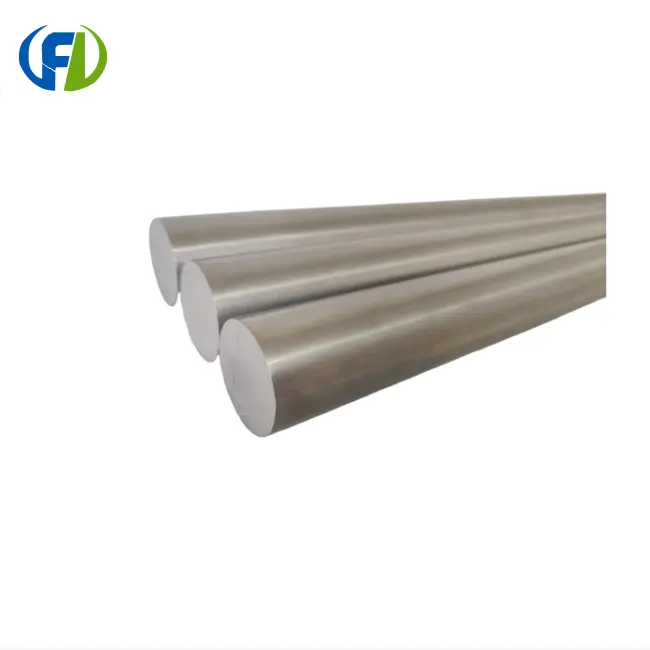
Crystal Structure: Alpha, Beta, and Mixed Phases
The crystal structure of titanium rods is a fascinating aspect that contributes significantly to their unique properties. Titanium exhibits allotropic behavior, meaning it can exist in different crystalline forms depending on temperature and alloying elements. The two primary phases in titanium are the alpha (α) and beta (β) phases.
Alpha Phase: Hexagonal Close-Packed (HCP) Structure
At room temperature, pure titanium exists in the alpha phase, characterized by a hexagonal close-packed (HCP) crystal structure. This arrangement provides excellent strength and creep resistance at lower temperatures. The alpha phase is stable up to about 882°C (1620°F) and is responsible for the material's high corrosion resistance and weldability.
Beta Phase: Body-Centered Cubic (BCC) Structure
Above the beta transus temperature of 882°C, titanium transforms into the beta phase, adopting a body-centered cubic (BCC) crystal structure. This phase offers improved formability and is more easily heat-treated. The beta structure contributes to the material's high strength-to-weight ratio and excellent fatigue resistance.
Mixed α+β Phase: The Best of Both Worlds
Many titanium rods are engineered to have a mixed α+β microstructure, combining the advantages of both phases. This is achieved through careful alloying and heat treatment processes. The resulting microstructure can be tailored to optimize specific properties such as strength, ductility, and toughness for various applications.
The ability to control the ratio and distribution of alpha and beta phases in titanium rods allows manufacturers to create materials with a wide range of mechanical properties. This versatility is one of the key factors that make titanium rods unique and highly sought after in industries ranging from aerospace to biomedical engineering.
Grain Boundaries: Influence on Mechanical Properties
The microstructure of titanium rods is not just about the crystal phases; the boundaries between individual grains play a crucial role in determining the material's overall behavior. Grain boundaries are the interfaces where crystals of different orientations meet within the metal.
Grain Size and Distribution
The size and distribution of grains in titanium rods significantly impact their mechanical properties. Finer grain structures generally lead to higher strength and improved fatigue resistance. This is because grain boundaries act as barriers to dislocation movement, the primary mechanism of plastic deformation in metals.
Conversely, larger grains can enhance ductility and creep resistance. The ability to control grain size through processing techniques such as hot working, cold working, and heat treatment allows manufacturers to tailor the properties of titanium rods for specific applications.
Grain Boundary Strengthening
Grain boundaries contribute to the strength of titanium rods through a phenomenon known as grain boundary strengthening or Hall-Petch strengthening. This effect describes the inverse relationship between grain size and yield strength. As the grain size decreases, the number of grain boundaries increases, providing more obstacles to dislocation movement and thus increasing the material's strength.
Texture and Anisotropy
The orientation of grains within titanium rods can lead to texture, which results in anisotropic properties. This means that the material's mechanical behavior may vary depending on the direction of applied stress relative to the grain orientation. Understanding and controlling texture is crucial in applications where directional properties are important, such as in aerospace components.
Grain Boundary Engineering
Advanced manufacturing techniques allow for precise control over grain boundary characteristics. This includes manipulating the type, distribution, and orientation of grain boundaries to optimize specific properties. For instance, certain types of grain boundaries can enhance resistance to stress corrosion cracking, a critical factor in many industrial applications of titanium rods.
The intricate interplay between grain size, orientation, and boundary characteristics in titanium rods underscores the complexity of their microstructure. It is this level of microstructural control that enables the production of titanium rods with an exceptional combination of strength, ductility, and corrosion resistance, making them uniquely suited for demanding applications across various industries.
Advanced Imaging: Peering into Titanium's Core
To truly understand what makes titanium rods unique, we must venture beyond what the naked eye can see. Advanced imaging techniques have revolutionized our ability to examine the microstructure of titanium, providing unprecedented insights into its internal features and behaviors.
Electron Microscopy: Revealing Nanoscale Details
Scanning Electron Microscopy (SEM) and Transmission Electron Microscopy (TEM) are powerful tools for investigating the microstructure of titanium rods. These techniques can reveal details at the nanometer scale, allowing researchers to observe grain boundaries, phase distributions, and even individual dislocations within the material.
SEM provides high-resolution images of surface topography and can be coupled with Energy Dispersive X-ray Spectroscopy (EDS) to analyze elemental composition. TEM, on the other hand, can provide information about crystal structure and internal defects by transmitting electrons through ultra-thin samples of titanium.
X-ray Diffraction: Probing Crystal Structure
X-ray diffraction (XRD) techniques offer valuable insights into the crystalline structure of titanium rods. By analyzing how X-rays scatter when they interact with the atomic planes in the material, researchers can determine the phases present, their relative proportions, and even residual stresses within the microstructure.
3D Tomography: Constructing Virtual Models
Advanced 3D imaging techniques, such as X-ray computed tomography (CT) and atom probe tomography, allow for the construction of three-dimensional models of titanium rod microstructures. These methods provide a comprehensive view of the material's internal features, including porosity, inclusions, and phase distributions throughout the volume of the sample.
In-situ Observations: Dynamic Microstructural Behavior
Cutting-edge in-situ techniques enable researchers to observe microstructural changes in titanium rods in real-time under various conditions. For example, in-situ TEM can reveal how dislocations move and interact during deformation, while high-temperature X-ray diffraction can track phase transformations as they occur.
Machine Learning and Image Analysis
The integration of machine learning algorithms with advanced imaging techniques is opening new frontiers in microstructural analysis. These tools can rapidly process large volumes of image data, identifying patterns and features that might be missed by human observers. This approach is particularly valuable for quantifying complex microstructural characteristics in titanium rods, such as grain size distributions and phase volume fractions.
By leveraging these advanced imaging and analysis techniques, researchers and engineers can gain a deeper understanding of the unique microstructural features that define the properties of titanium rods. This knowledge is crucial for developing new alloys, optimizing processing techniques, and predicting the performance of titanium components in various applications.
The ability to peer into the core of titanium at such high resolutions and in such detail is not just an academic exercise. It has practical implications for quality control in manufacturing, failure analysis in engineering applications, and the development of next-generation titanium alloys with even more exceptional properties.
Conclusion
The unique properties of titanium rods are a direct result of their complex and carefully engineered microstructure. From the interplay of alpha and beta phases to the critical role of grain boundaries and the insights provided by advanced imaging techniques, every aspect of titanium's microstructure contributes to its exceptional performance. Understanding these microstructural features is key to harnessing the full potential of titanium rods in various applications.
For those seeking high-quality titanium rods tailored to specific industrial needs, Baoji Freelong New Material Technology Development Co., Ltd. stands as a leading provider. Located in Baoji City, China's Titanium Valley, we specialize in the production and export of titanium, zirconium, nickel, niobium, tantalum, and other advanced alloys. Our commitment to quality and customer satisfaction has earned us the trust of clients across Australia, Korea, Germany, the US, UK, Malaysia, Azerbaijan, the Middle East, and Taiwan.
Whether you're in aerospace, medical technology, or any industry requiring premium titanium products, we invite you to experience the Freelong difference. Our team of experts is ready to assist you in finding the perfect titanium solution for your needs. For more information or to discuss your specific requirements, please contact us at jenny@bjfreelong.com. Let us help you unlock the full potential of titanium in your applications.
References
1. Lutjering, G., & Williams, J. C. (2007). Titanium (2nd ed.). Springer-Verlag Berlin Heidelberg.
2. Banerjee, D., & Williams, J. C. (2013). Perspectives on Titanium Science and Technology. Acta Materialia, 61(3), 844-879.
3. Leyens, C., & Peters, M. (Eds.). (2003). Titanium and Titanium Alloys: Fundamentals and Applications. Wiley-VCH.
4. Donachie, M. J. (2000). Titanium: A Technical Guide (2nd ed.). ASM International.
5. Rack, H. J., & Qazi, J. I. (2006). Titanium alloys for biomedical applications. Materials Science and Engineering: C, 26(8), 1269-1277.
6. Boyer, R. R. (1996). An overview on the use of titanium in the aerospace industry. Materials Science and Engineering: A, 213(1-2), 103-114.

_1745821959752.webp)
_1746002567971.webp)
_1745395351966.webp)
_1745219223121.webp)